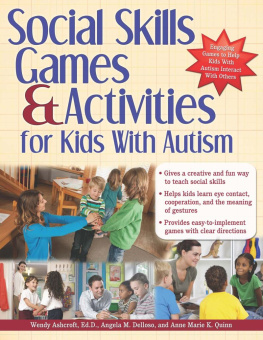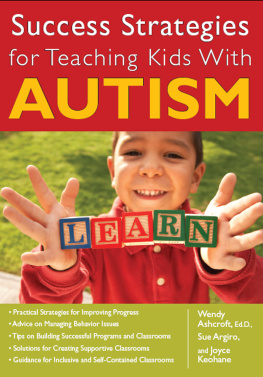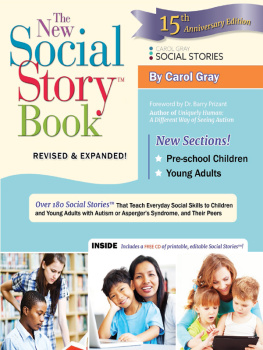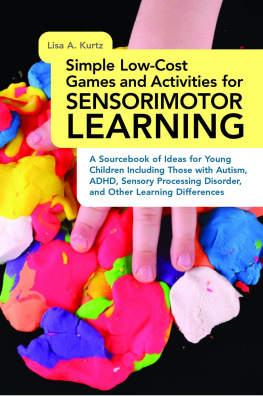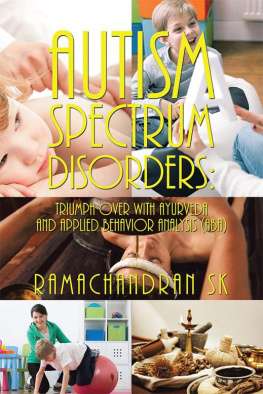About the Authors
Wendy Ashcroft, Ed.D., Angela M. Delloso, M.S., and Anne Marie K. Quinn, M.S., are experienced teachers and consultants dedicated to teaching children with autism. They are known at local, state, and international levels for their evidence-based professional development and collaborative parent training sessions.
Chapter 1
Social Skills and Children With ASD
Social Skills
Social interactions fill our lives. A typical day with others can start with greetings and exchanges at breakfast, conversing about the previous day, cooperating and collaborating on projects at school, participating in afterschool recreation activities, relating events of the day during dinner, and associating with family members in the evening.
Elliott, Racine, and Busse (1995) have defined the skills needed for such interactions as learned responses that enable people to interact in ways that result in positive, and avoid negative, responses from others. Most people learn these skills during their development. Immediately after birth, typically developing children perceive and analyze the responses of people to their actions. They observe how their mothers respond with attention to their cries, and they soon learn to communicate their needs for food and care. Before they are even 2 years old, even if their speech isnt intelligible, they look at others and imitate social exchanges. Soon, they learn to make requests and comments, wait, take turns, and share. Most of these skills are learned in the context of their natural environment by watching others, imitating and experimenting, and responding to the feedback they receive from others.
However, social interactions are complex, and it takes practice and work to maintain positive social relationships. In the early stages of social development, young children may struggle with learning social behavior. For example, children may be confused about when it is acceptable to interrupt conversations or make requests. They might walk between people who are conversing or ask for things when someone is busy with an important task. Or they may ask questions that are appropriate to ask at home to strangers and make statements that others consider to be offensive.
Even as adults, we can misinterpret the intentions, communications, and actions of other people. We might misread raised eyebrows as surprise when the person is really taking offense. Or we might see a stare as a need for further explanation rather than a communication of boredom. There are also times that we are perplexed by the reactions of other people to our communications. For example, we sometimes compliment a person who then cries, or scold a child who then laughs, or joke with a person who then becomes angry.
When the reactions of others make sense to us, we have usually gained some knowledge of the previous history or current state of another person. The history or state influences their responses, so it might be that the complimented person is exhausted and relieved or that the scolded child who laughs is anxious and is relieving the anxiety by laughing. A person who has been bullied or abused may take a joke seriously and become angered by its insensitivity.
Under the best of circumstances, it can be difficult to maintain and enjoy relationships with others. As well discuss in the , children with autism spectrum disorders have characteristics that make it especially challenging to develop the special friendships that make childhood so rich and wonderful.
Children With Autism Spectrum Disorders
Autism spectrum disorders (ASD) are complex conditions defined by specific behavior patterns and characteristics. Children with ASD have impairments in communication and social interaction. In addition, they have restrictive, repetitive, and stereotypic patterns of behavior as well as narrow interests and activities. Because these disorders are defined by certain sets of behaviors, it is known as a spectrum disorder, one that affects individuals differently and to various degrees. ASD includes children with widely varying differences in these attributes, and we find each child with an ASD to be a unique, fascinating, and wonderful individual.
Autism is considered to be of neurological origin, and brain scans show structural differences between the brains of children with ASD and children who are developing typically. No single cause has been identified and it is likely that the origin of ASD will eventually be linked to combinations of genetic and environmental factors. There is evidence that autism runs in some families, thus giving strength to the supposition that there is some genetic predisposition to ASD. However, so far, researchers have not been able to determine that genetic factors alone cause autism. A number of environmental stresses have been identified. These include exposure to environmental toxins or chemicals, viral infections, metabolic imbalances, advanced parental age, maternal illness during pregnancy, and certain difficulties during birth. These factors, by themselves, do not cause ASD, but, in combination with genetic risk factors, they seem to increase risk.
In the past decade, there has been tremendous growth in the number of children diagnosed with ASD. In fact, one study reported a 1,148% increase between 1987 and 2007 (Cavagnaro, 2007). Although there are still some who believe this growth is due to increased awareness and broad diagnoses, most careful research shows that there is a true increase. The prevalence is now estimated at 1 in 88 (Centers for Disease Control and Prevention, 2012).
ASD is generally diagnosed before the age of 3 and usually affects a person throughout life. Some people with ASD are able to live independent lives but others may have needs requiring a lifetime of support. There is no simple medical test that can be used to diagnose ASD. However, using the guidelines in the text revision of the fourth edition of the American Psychiatric Associations Diagnostic and Statistical Manual (DSM-IV-TR, 2000), a physician can make a medical diagnosis based on an assessment of symptoms, diagnostic tests, developmental history, and input from people who know the child.
To determine if a child with ASD is eligible for services under the Individuals with Disabilities Education Improvement Act (IDEA, 2004), a multidisciplinary evaluation team comprised of various school professionals must determine that the disorder interferes with the childs ability to succeed in the general education setting and curriculum. Although states vary in the actual requirements, most multidisciplinary teams need evaluation results from the physician, a speech-language pathologist, and an educational or psychological diagnostician (IDEA, 2004).
In this book, we have provided suggestions for teaching children who have the following three kinds of ASD: classic autism, Aspergers syndrome, and Pervasive Developmental DisorderNot Otherwise Specified. Classic autism (also referred to as autistic disorder) includes children who have significant language delays, social and communication challenges, unusual behaviors and interests, and sometimes an accompanying intellectual disability. Aspergers syndrome (AS) is a form of autism also characterized by social challenges and unusual behaviors and interests. Most children with AS do not have language delays or intellectual disabilities, but still can have difficulties with social communication. The third group is composed of children who have diagnoses of Pervasive Developmental DisorderNot Otherwise Specified (PDDNOS). Generally, these children have fewer and milder difficulties with social, communication, and behavior challenges.
We designed this book for teachers and parents who have children who range from about 512 years old. However, it may be useful for some younger children who have good language skills and some older children with language delays. We believe the games and activities can be adjusted to meet the interests of the particular children you teach.
Next page
